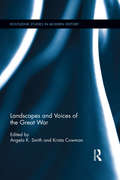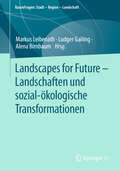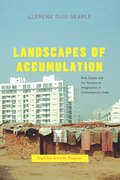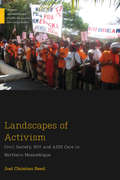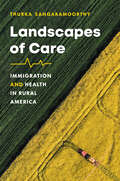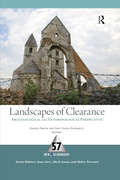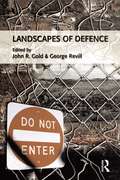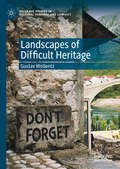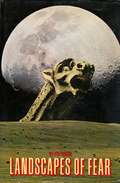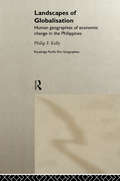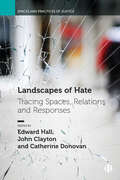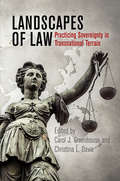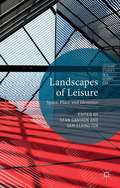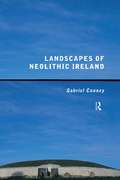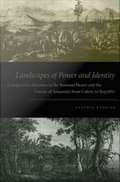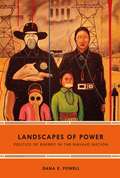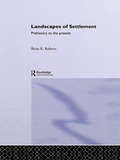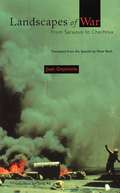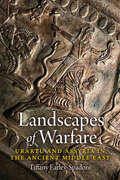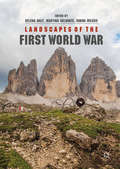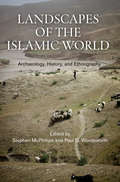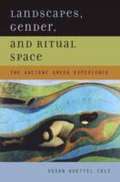- Table View
- List View
Landscapes and Voices of the Great War (Routledge Studies in Modern History #22)
by Angela K. Smith Krista CowmanThis volume aims to provide a wider view of First World War experience through focusing on landscapes less commonly considered in historiography, and on voices that have remained on the margins of popular understanding of the war. The landscape of the western front was captured during the conflict in many different ways: in photographs, paintings and print. The most commonly replicated voicing of contemporary attitudes towards the war is that of initial enthusiasm giving way to disillusionment and a sense of overwhelming futility. Investigations of the many components of war experience drawn from social and cultural history have looked to landscapes and voices beyond the frontline as a means of foregrounding different perspectives on the war. Not all of the voices presented here opposed the war, and not all of the landscapes were comprised of trenches or flanked by barbed wire. Collectively, they combine to offer further fresh insights into the multiplicity of war experience, an alternate space to the familiar tropes of mud and mayhem.
Landscapes for Future – Landschaften und sozial-ökologische Transformationen (RaumFragen: Stadt – Region – Landschaft)
by Ludger Gailing Markus Leibenath Alena BirnbaumWeltweite Krisenphänomene wie der Klimawandel, der rapide Schwund von Tier- und Pflanzenarten sowie der Verlust wertvoller Böden verdeutlichen, dass sozial-ökologische Transformationen nötig sind – insbesondere in wohlhabenden Staaten wie Deutschland, Österreich und der Schweiz. Bei diesen tiefgreifenden Veränderungen können Landschaften eine wichtige Rolle spielen, weil sie sowohl Grundlage als auch Ergebnis unserer Wirtschafts- und Lebensweise sind.Dieses Buch gibt einen umfassenden Überblick über die Zusammenhänge zwischen Landschaftsdenken und sozial-ökologischem Wandel und beantwortet Fragen wie:Welche Vorstellungen von einem transformativen Landschaftswandel gibt es? Wie arbeiten wir mit ihnen in der Praxis?Wie initiiert man Prozesse der Reflexion und Kommunikation über nachhaltige Landschaften?Welche Rolle können Planer:innen und andere Akteur:innen im Landschaftswandel hin zu größerer Nachhaltigkeitspielen?Welche Governance-Ansätze können genutzt werden, um landschaftsbezogene Transformationsprozesse zu gestalten? Welche Bedeutung haben z.B. Großschutzgebiete - also etwa Biosphärenreservate - oder Regionalparks in diesem Zusammenhang?Welche Widerstände und Konflikte gibt es und wie kann mit ihnen umgegangen werden?Welche Beispiele gibt es, in denen Landschaften als Experimentierräume oder Reallabore für sozial-ökologische Transformationen genutzt werden?
Landscapes of Accumulation: Real Estate and the Neoliberal Imagination in Contemporary India (South Asia Across the Disciplines)
by Llerena Guiu SearleOver the past few decades, India has experienced a sudden and spectacular urban transformation. Gleaming business complexes encroach on fields and villages. Giant condominium communities offer gated security, indoor gyms, and pristine pools. Spacious, air-conditioned malls have sprung up alongside open-air markets. In Landscapes of Accumulation, Llerena Guiu Searle examines India's booming developments and offers a nuanced ethnographic treatment of late capitalism. India's land, she shows, is rapidly transforming from a site of agricultural and industrial production to an international financial resource. Drawing on intensive fieldwork with investors, developers, real estate agents, and others, Searle documents the new private sector partnerships and practices that are transforming India's built environment, as well as widely shared stories of growth and development that themselves create self-fulfilling prophecies of success. As a result, India's cities are becoming ever more inaccessible to the country's poor. Landscapes of Accumulation will be a welcome contribution to the international study of neoliberalism, finance, and urban development and will be of particular interest to those studying rapid--and perhaps unsustainable--development across the Global South.
Landscapes of Activism: Civil Society, HIV and AIDS Care in Northern Mozambique (Medical Anthropology)
by Joel Christian ReedAIDS activists are often romanticized as extremely noble and selfless. However, the relationships among HIV support group members highlighted in Landscapes of Activism are hardly utopian or ideal. At first, the group has everything it needs, a thriving membership, and support from major donors. Soon, the group undergoes an identity crisis over money and power, eventually fading from the scene. As government and development institutions embraced activist demands—decentralizing AIDS care through policies of health systems strengthening—civil society was increasingly rendered obsolete. Charting this transition—from subjects, to citizens, and back again—reveals the inefficacy of protest, and the importance of community resilience. The product of in-depth ethnography and focused anthropological inquiry, this is the first book on AIDS activists in Mozambique. AIDS activism’s strange decline in southern Africa, rather than a reflection of citizen apathy, is the direct result of targeted state and donor intervention.
Landscapes of Care: Immigration and Health in Rural America (Studies in Social Medicine)
by Thurka SangaramoorthyThis insightful work on rural health in the United States examines the ways immigrants, mainly from Latin America and the Caribbean, navigate the health care system in the United States. Since 1990, immigration to the United States has risen sharply, and rural areas have seen the highest increases. Thurka Sangaramoorthy reveals that that the corporatization of health care delivery and immigration policies are deeply connected in rural America. Drawing from fieldwork that centers on Maryland's sparsely populated Eastern Shore, Sangaramoorthy shows how longstanding issues of precarity among rural health systems along with the exclusionary logics of immigration have mutually fashioned a "landscape of care" in which shared conditions of physical suffering and emotional anxiety among immigrants and rural residents generate powerful forms of regional vitality and social inclusion. Sangaramoorthy connects the Eastern Shore and its immigrant populations to many other places around the world that are struggling with the challenges of global migration, rural precarity, and health governance. Her extensive ethnographic and policy research shows the personal stories behind health inequity data and helps to give readers a human entry point into the enormous challenges of immigration and rural health.
Landscapes of Clearance: Archaeological and Anthropological Perspectives (One World Archaeology Ser. #57)
by Angèle Smith Amy Gazin-SchwartzThis volume examines landscapes that have been cleared of inhabitants—for economic, environmental, or socio-political reasons, by choice or by force—and the social impacts of clearance on their populations. Using cases from five continents, and ranging from prehistoric, through colonial and post-colonial times, the contributors show landscapes as meaningful points of contestation when populations abandon them or are exiled from them. Acts of resistance and revitalization are also explored, demonstrating the social and political meaning of specific landscapes to individuals, groups, and nations, and how they help shape cultural identity and ideology.Sponsored by the World Archaeological Congress
Landscapes of Defence
by George Revill John R. GoldThis is a key text on the very topical themes of power, defence and space. Landscapes of Defence is an exciting collection of theoretical and empirical material from very well known contributors, desiged to help students understand how landscapes of defence fit in with some of the broader concepts of space, power and place to which they are introduced in the 1st year. The book is split into four sections, and each section contains an introduction placing the subsequent chapters in context. There is also a comprehensive introduction and afterword to tie the book's broad themes together. 2nd and 3rd year undergraduates in urban and cultural geography will be the key market for this title, as well as strong secondary market in departments of Sociology, Anthropology, Law and Planning.
Landscapes of Difficult Heritage (Palgrave Studies in Cultural Heritage and Conflict)
by Gustav WollentzThis book studies how people negotiate difficult heritage within their everyday lives, focusing on memory, belonging, and identity. The starting point for the examination is that temporalities lie at the core of understanding this negotiation and that the connection between temporalities and difficult heritage remains poorly understood and theorized in previous research. In order to fully explore the temporalities of difficult heritage, the book investigates places in which the incident of violence originated within different time periods. It examines one example of modern violence (Mostar in Bosnia and Herzegovina), one example of where the associated incident occurred during medieval times (the Gazimestan monument in Kosovo), and one example of prehistoric violence (Sandby borg in Sweden). The book presents new theoretical perspectives andprovides suggestions for developing sites of difficult heritage, and will thus be relevant for academic researchers, students, and heritage professionals.
Landscapes of Fear
by Yi-Fu TuanTo be human is to experience fear, but what is it exactly that makes us fearful?Landscapes of Fear—written immediately after his classicSpace and Place—is renowned geographer Yi-Fu Tuan’s influential exploration of the spaces of fear and of how these landscapes shift during our lives and vary throughout history. In a series of linked essays that journey broadly across place, time, and cultures, Tuan examines the diverse manifestations and causes of fear in individuals and societies: he describes the horror created by epidemic disease and supernatural visions of witches and ghosts; violence and fear in the country and the city; fears of drought, flood, famine, and disease; and the ways in which authorities devise landscapes of terror to instill fear and subservience in their own populations. In this groundbreaking work—now with a new preface by the author—Yi-Fu Tuan reaches back into our prehistory to discover what is universal and what is particular in our inheritance of fear. Tuan emphasizes that human fear is a constant; it causes us to draw what he calls our “circles of safety” and at the same time acts as a foundational impetus behind curiosity, growth, and adventure.
Landscapes of Fear
by Yi-Fu TuanTo be human is to experience fear, but what is it exactly that makes us fearful? Landscapes of Fear—written immediately after his classic Space and Place—is renowned geographer Yi-Fu Tuan&’s influential exploration of the spaces of fear and of how these landscapes shift during our lives and vary throughout history.In a series of linked essays that journey broadly across place, time, and cultures, Tuan examines the diverse manifestations and causes of fear in individuals and societies: he describes the horror created by epidemic disease and supernatural visions of witches and ghosts; violence and fear in the country and the city; fears of drought, flood, famine, and disease; and the ways in which authorities devise landscapes of terror to instill fear and subservience in their own populations. In this groundbreaking work—now with a new preface by the author—Yi-Fu Tuan reaches back into our prehistory to discover what is universal and what is particular in our inheritance of fear. Tuan emphasizes that human fear is a constant; it causes us to draw what he calls our &“circles of safety&” and at the same time acts as a foundational impetus behind curiosity, growth, and adventure.
Landscapes of Globalization: Human Geographies of Economic Change in the Philippines (Routledge Pacific Rim Geographies)
by Philip F. KellyIn this critical and sophisticated analysis, Philip F. Kelly challenges the conventional definition of globalization as an irresistible and inevitable force to which societies must succumb. By tracing the consequences of global economic integration in the Philippines, he argues that global processes are constituted, accommodated, mediated and resisted in social processes at multiple scales, from the national economy to the village and the household.
Landscapes of Hate: Tracing Spaces, Relations and Responses (Spaces and Practices of Justice)
by Edward Hall, John Clayton and Catherine DonovanProviding a much-needed perspective on exclusion and discrimination, this book offers a distinct spatial approach to the topic of hate studies. Of interest to academics and students of human geography, criminology, sociology and beyond, the book highlights enduring, diverse and uneven experiences of hate in contemporary society. The collection explores the intersecting experiences of those targeted on the basis of assumed and historically marginalized identities. It illustrates the role of specific spaces and places in shaping hate, why space matters for how hate is encountered and the importance of space in challenging cultures of hate. This analysis of who is able to use or abuse space offers a novel insight into discourses of hate and lived experiences of victimization.
Landscapes of Hope: Nature And The Great Migration In Chicago
by Brian McCammackIn the first interdisciplinary history to frame the African American Great Migration as an environmental experience, Brian McCammack travels to Chicago’s parks and beaches as well as farms and forests of the rural Midwest, where African Americans retreated to relax and reconnect with southern identities and lifestyles they had left behind.
Landscapes of Law: Practicing Sovereignty in Transnational Terrain
by Christina L. Davis Carol J. GreenhouseInternational scholars offer ethnographic analyses of the relations between transnationalism, law, and cultureThe recent surge of right-wing populism in Europe and the United States is widely perceived as evidence of ongoing challenges to the policies and institutions of globalization. But as editors Carol J. Greenhouse and Christina L. Davis observe in their introduction to Landscapes of Law, the appeal to national culture is not restricted to the ethno-nationalisms of the developing world outside of industrial democracies nor to insurgent groups within them. The essays they have collected in this volume reveal how claims of national culture emerge in the pursuit of transnationalism and, under some circumstances, become embedded within international law. The premise that there is inherent tension between nationalism and globalism is misleading. Whether asserted explicitly as state sovereignty or implicitly as cultural community, claims of national culture mediate how governments assert their interests and values when engaging with transnational law. Landscapes of Law demonstrates how nationalism operates in the contested zone between borderless capital and bordered states.Drawing from the fields of anthropology, international relations, law, political science, and sociology, the book's international contributors examine the ways in which claims of national differences are produced within transnational institutions. Insights from case studies across a wide range of topics reveal how such claims may be worked into policy prescriptions and legal arrangements or provide ad hoc bargaining chips. Together, they show that expressions of national culture outside of state boundaries consolidate claims of sovereignty. The contributors offer innovative frameworks for analyzing the relationships among transnationalism, law, and cultural claims at various levels and scales. They demonstrate how overlapping communities use law to define borders and shape relationships among actors rather than to generate a single social ordering.Landscapes of Law traces the theoretical implications generated by an understanding of transnational law that challenges the conventional separation of individual, community, society, national, and international spaces.Contributors: Katayoun Alidadi, Tugba Basaran, Rachel Brewster, Sandra Brunnegger, Christina L. Davis, Sara Dezalay, Marie-Claire Foblets, Henry Gao, Carol J. Greenhouse, David Leheny, Mark Fathi Massoud, Teresa Rodríguez-de-las-Heras Ballell, Gregory Shaffer, Mariana Valverde.
Landscapes of Leisure
by Sean Gammon Sam ElkingtonThe leisure landscape is a complex and diverse one that is both natural and built, dark and light, safe and dangerous, contained or without boundary, and profoundly influences the manner in which leisure is performed and experienced. These leisurescapes are increasingly becoming significant sites for the construction of individual and shared frameworks in which people orient themselves and act in wider society. Drawing on international contributions by leading researchers in the field, this collection aims to map out the complex relationship that leisure has with place. A key element of the volume will be to illustrate the transdisciplinarity of this key feature of leisure studies, and by doing so offer, for the first time, a more rounded and inclusive approach to the study of leisure and place. It also aims to explore and elucidate the extent to which leisure places and spaces form, affect and influence personal, social and collective identities.
Landscapes of Neolithic Ireland
by Gabriel CooneyLandscapes of Neolithic Ireland is the first volume to be devoted solely to the Irish Neolithic, using an innovative landscape and anthropological perspective to provide significant new insights on the period. Gabriel Cooney argues that the archaeological evidence demonstrates a much more complex picture than the current orthodoxy on Neolithic Europe, with its assumption of mobile lifestyles, suggests. He integrates the study of landscape, settlement, agriculture, material culture and burial practice to offer a rounded, realistic picture of the complexities and the realities of Neolithic lives and societies in Ireland.
Landscapes of Power and Identity: Comparative Histories in the Sonoran Desert and the Forests of Amazonia from Colony to Republic
by Cynthia RaddingLandscapes of Power and Identity is a groundbreaking comparative history of two colonies on the frontiers of the Spanish empire--the Sonora region of northwestern Mexico and the Chiquitos region of eastern Bolivia's lowlands--from the late colonial period through the middle of the nineteenth century. An innovative combination of environmental and cultural history, this book reflects Cynthia Radding's more than two decades of research on Mexico and Bolivia and her consideration of the relationships between human societies and the geographic landscapes they inhabit and create. At first glance, Sonora and Chiquitos are quite different: one a scrub-covered desert, the other a tropical rainforest of the greater Amazonian and Paraguayan river basins. Yet the regions are similar in many ways. Both were located far from the centers of colonial authority, organized into Jesuit missions and linked to the principal mining centers of New Spain and the Andes, and then absorbed into nation-states in the nineteenth century. In each area, the indigenous communities encountered European governors, missionaries, slave hunters, merchants, miners, and ranchers. Radding's comparative approach illuminates what happened when similar institutions of imperial governance, commerce, and religion were planted in different physical and cultural environments. She draws on archival documents, published reports by missionaries and travelers, and previous histories as well as ecological studies and ethnographies. She also considers cultural artifacts, including archaeological remains, architecture, liturgical music, and religious dances. Radding demonstrates how colonial encounters were conditioned by both the local landscape and cultural expectations; how the colonizers and colonized understood notions of territory and property; how religion formed the cultural practices and historical memories of the Sonoran and Chiquitano peoples; and how the conflict between the indigenous communities and the surrounding creole societies developed in new directions well into the nineteenth century.
Landscapes of Power: Politics of Energy in the Navajo Nation
by Dana E. PowellIn Landscapes of Power Dana E. Powell examines the rise and fall of the controversial Desert Rock Power Plant initiative in New Mexico to trace the political conflicts surrounding Native sovereignty and contemporary energy development on Navajo (Diné) Nation land. Powell's historical and ethnographic account shows how the coal-fired power plant project's defeat provided the basis for redefining the legacies of colonialism, mineral extraction, and environmentalism. Examining the labor of activists, artists, politicians, elders, technicians, and others, Powell emphasizes the generative potential of Navajo resistance to articulate a vision of autonomy in the face of twenty-first-century colonial conditions. Ultimately, Powell situates local Navajo struggles over energy technology and infrastructure within broader sociocultural life, debates over global climate change, and tribal, federal, and global politics of extraction.
Landscapes of Settlement: Prehistory to the Present (British Archaeological Reports International Ser.)
by Brian RobertsFirst published in 2004. Routledge is an imprint of Taylor & Francis, an informa company.
Landscapes of War: From Sarajevo to Chechnya
by Juan Goytisolo Peter BushAn incisive examination of the tensions that exist between the West and Islamic societies of Europe, North Africa, and the Middle East. Provides rich historical analysis and reportage of life in four explosive war-zones: Sarajevo, Algeria, the West Bank and Gaza, and Chechnya. Translated by Peter Bush.
Landscapes of Warfare: Urartu and Assyria in the Ancient Middle East
by Tiffany Earley-SpadoniLandscapes of Warfare offers an in-depth exploration of the Urartian empire, which occupied the highlands of present-day Turkey, Armenia, and Iran in the early first millennium BCE. Lesser known than its rival, the Neo-Assyrian empire, Urartu presents a unique case of imperial power distributed among mountain fortresses rather than centralized in cities. Through spatial analysis, the book demonstrates how systematic warfare, driven by imperial ambitions, shaped Urartian and Assyrian territories, creating symbolically and materially powerful landscapes. Tiffany Earley-Spadoni challenges traditional views by emphasizing warfare’s role in organizing ancient landscapes, suggesting that Urartu’s strength lay in its strategic optimization of terrain through fortified regional networks. Using an interdisciplinary approach that includes GIS-enabled studies and integrates archaeological, historical, and art-historical evidence, she illustrates how warfare was a generative force in structuring space and society in the ancient Middle East. Landscapes of Warfare situates Urartu’s developments within the broader context of regional empires, providing insights into the mechanisms of warfare, governance, and cultural identity formation.
Landscapes of the Anthropocene with Google Earth
by Andrew GoudieThis book considers the meaning of the term, considers the value and characteristics of Google Earth, and discusses the main driving forces of landscape change. Google Earth provides a means whereby one can identify changes in the landscapes of Earth over recent decades. This has been a time of great human activity, and landscapes have been transformed as a result of such factors as land use and land-cover change, climate change, the intensive harnessing of new energy sources, population pressures, and globalization. Many geologists now believe that the whole Earth System is being changed and that there is thus a need to introduce the concept of the Anthropocene. It then looks at specific landscape types, including rivers, coasts, lakes, deserts, tundra, and glaciers.
Landscapes of the First World War
by Vanda Wilcox Selena Daly Martina SalvanteThis comparative and transnational study of landscapes in the First World War offers new perspectives on the ways in which landscapes were idealised, mobilised, interpreted, exploited, transformed and destroyed by the conflict. The collection focuses on four themes: environment and climate, industrial and urban landscapes, cross-cultural encounters, and legacies of the war. The chapters cover Europe, Russia, the Middle East, Africa and the US, drawing on a range of approaches including battlefield archaeology, military history, medical humanities, architecture, literary analysis and environmental history. This volume explores the environmental impact of the war on diverse landscapes and how landscapes shaped soldiers’ experiences at the front. It investigates how rural and urban locales were mobilised to cater to the demands of industry and agriculture. The enduring physical scars and the role of landscape as a crucial locus of memory and commemoration are also analysed. The chapter 'The Long Carry: Landscapes and the Shaping of British Medical Masculinities in the First World War' is open access under a CC BY 4.0 license via link.springer.com.
Landscapes of the Islamic World: Archaeology, History, and Ethnography
by Stephen McPhillips Paul D. WordsworthIslamic societies of the past have often been characterized as urban, with rural and other extra-urban landscapes cast in a lesser or supporting role in the studies of Islamic history and archaeology. Yet throughout history, the countryside was frequently an engine of economic activity, the setting for agricultural and technological innovation, and its inhabitants were frequently agents of social and political change. The Islamic city is increasingly viewed in the context of long and complex processes of urban development. Archaeological evidence calls for an equally nuanced reading of shifting cultural and religious practices in rural areas after the middle of the seventh century.Landscapes of the Islamic World presents new work by twelve authors on the archaeology, history, and ethnography of the Islamic world in the Middle East, the Arabian Peninsula, and Central Asia. The collection looks beyond the city to engage with the predominantly rural and pastoral character of premodern Islamic society. Editors Stephen McPhillips and Paul D. Wordsworth group the essays into four thematic sections: harnessing and living with water; agriculture, pastoralism, and rural subsistence; commerce, production, and the rural economy; and movement and memory in the rural landscape. Each contribution addresses aspects of extra-urban life in challenging new ways, blending archaeological material culture, textual sources, and ethnography to construct holistic studies of landscapes.Modern agrarian practices and population growth have accelerated the widespread destruction of vast tracts of ancient, medieval, and early modern landscapes, highlighting the urgency of scholarship in this field. This book makes an original and important contribution to a growing subject area, and represents a step toward a more inclusive understanding of the historical landscapes of Islam.Contributors: Pernille Bangsgaard, Karin Bartl, Jennie N. Bradbury, Robin M. Brown, Alison L. Gascoigne, Ian W. N. Jones, Phillip G. Macumber, Daniel Mahoney, Stephen McPhillips, Astrid Meier, David C. Thomas, Bethany J. Walker, Alan Walmsley, Tony J. Wilkinson, Paul D. Wordsworth, Lisa Yeomans.
Landscapes, Gender, and Ritual Space (The Ancient Greek Experience)
by Susan Guettel ColeThe division of land and consolidation of territory that created the Greek polis also divided sacred from productive space, sharpened distinctions between purity and pollution, and created a ritual system premised on gender difference. Regional sanctuaries ameliorated competition between city-states, publicized the results of competitive rituals for males, and encouraged judicial alternatives to violence. Female ritual efforts, focused on reproduction and the health of the family, are less visible, but, as this provocative study shows, no less significant. Taking a fresh look at the epigraphical evidence for Greek ritual practice in the context of recent studies of landscape and political organization, Susan Guettel Cole illuminates the profoundly gendered nature of Greek cult practice and explains the connections between female rituals and the integrity of the community. In a rich integration of ancient sources and current theory, Cole brings together the complex evidence for Greek ritual practice. She discusses relevant medical and philosophical theories about the female body; considers Greek ideas about purity, pollution, and ritual purification; and examines the cult of Artemis in detail. Her nuanced study demonstrates the social contribution of women's rituals to the sustenance of the polis and the identity of its people.
